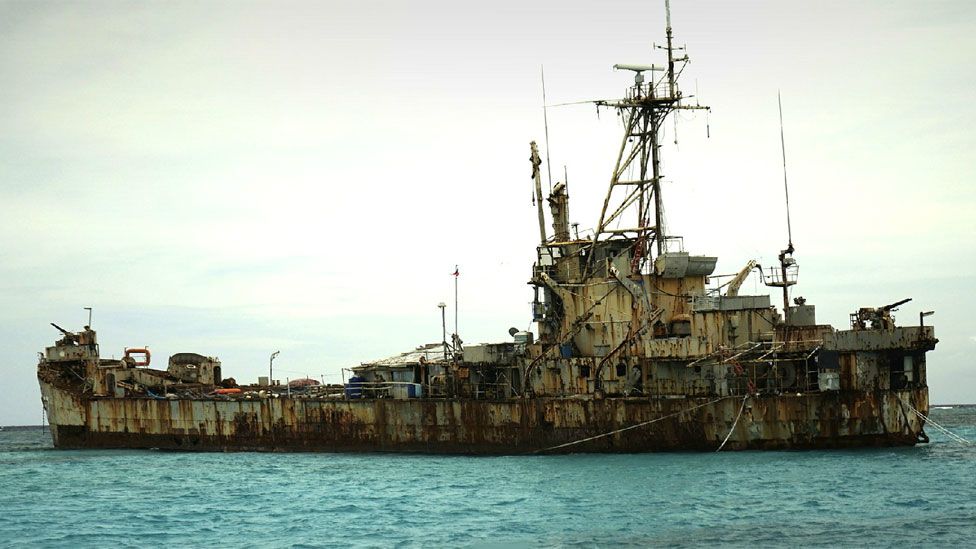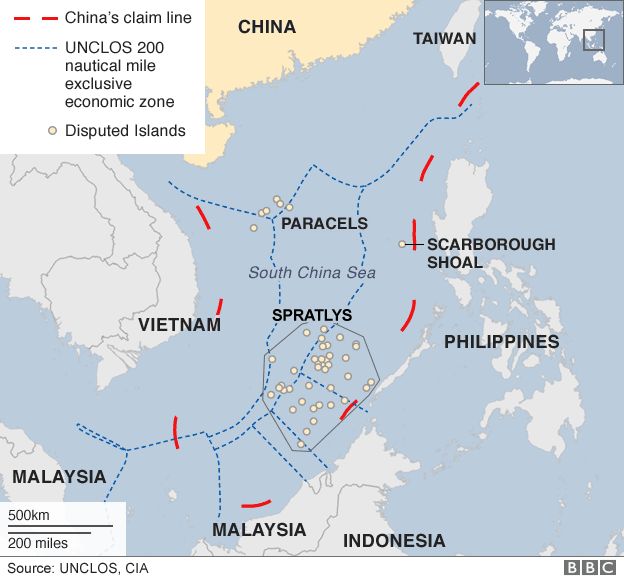China has had an unusually busy and bizarre week.
On Monday – as the saga over the alleged spy balloon dragged into its 11th day – a fresh spat erupted between Beijing and Manila. This one was over lasers.
The Philippines accused China of using a “military grade” laser light on a Philippine coastguard boat. It said the incident had happened on 6 February when the boat was attempting to take supplies to the Sierra Madre, a vessel that is used as a Filipino naval outpost in the South China Sea; and that a Chinese vessel intercepted the Filipino coast guard boat, blocked its way and used a laser device to temporarily blind the crew.
It’s not clear what sort of device the Chinese crew used or how powerful it was, but laser weapons designed to damage eyesight are banned under UN convention. The incident has been quickly condemned by a host of countries including the United States, Australia, Japan and Germany.
China for its part defended its right to use lasers to protect its “sovereignty”, and then denied shining the light at the Filipino crew, saying they had used a “hand-held laser speed detector and hand-held greenlight pointer”, neither of which are dangerous.
All this over a submerged reef.
In 2014, the BBC visited the South China Sea in search of the Sierra Madre. As the sun rose across the South China Sea, the horizon showed no sign of our quarry.
“Don’t worry,” shouted the skipper who was taking us to the ship above the sound of the engine, “I know where I’m going. It’s on the reef over there.”
He pointed north and out of the morning mist appeared a rusting grey hulk sitting, grounded, atop the vast submerged reef visible just a few feet below the water.
The Sierra Madre was not a particularly grand ship even in its youth. Built as a tank landing ship during World War Two, it served with the US navy in the Vietnam war. In 1970 she was transferred to the South Vietnamese navy, and after the fall of Saigon in 1975 she ended up in the Philippines. In 1999 the ageing ship was deliberately beached on top of this reef 160km (100 miles) off the Philippine coast.

As the little fishing boat drew close, large holes rusted right through the ship’s hull became visible. It looked like the next typhoon would wash her away.
Nearly 10 years on, the Sierra Madre is somehow still holding together, more rust and concrete, than steel. And a tiny contingent of Filipino marines still live a precarious existence aboard.
The actions of the Chinese coastguard ship in blocking the Philippine vessel may also breach international law. Whatever Beijing says, the waters around the rusting Sierra Madre do not belong to China.
In 2016 the Permanent Court of Arbitration in the Hague made a clear ruling. China’s claim to a large swathe of the South China Sea, often defined as the nine-dash line, has no basis in international law.
Of course, it’s not quite as simple as that.
There are numerous claims and counter-claims to the islands, reefs and waters of the South China Sea. China’s is only the most expansive. The Philippines, Vietnam, Taiwan and Malaysia all have their own overlapping claims to smaller bits of the sea. And most of those claims are also not supported by international law.
The Philippines’ rusting Sierra Madre sits atop a reef variously known as Second Thomas Shoal, Ayungin Shoal and – in Chinese – Ren-ai Reef. But a submerged reef is not land and controlling a reef does not give a country any new territorial waters and does not expand its Exclusive Economic Zone (EEZ).
There is almost no real land in the South China Sea. In the most hotly contested area, known as the Spratly Islands, there are a handful of tiny islets. The biggest is called Taiping Dao. It’s just 1,000 metres long and 400 metres wide.
By an accident of history, it has ended up under the control of Taiwan. The second biggest is called Pagasa. You can walk around it in half an hour. Pagasa was snatched by the Philippines in 1971, when the Taiwanese troops stationed there withdrew to escape a powerful typhoon. Vietnam has a few other scraps of land.
But China, distracted by the internal turmoil of the Cultural Revolution in the 1960s and 1970s, was too late – and ended up with no real land. So, it decided to make its own.

In 2014, while a handful of Filipino marines clung to the rusting decks of the Sierra Madre, 40km (25 miles) away on another atoll called Mischief Reef, China had begun a massive land reclamation project. The world’s largest ocean-going dredgers were pumping millions of tonnes of gravel and sand on to the top of the reef creating a huge artificial island.
The new land China has made at Mischief Reef is well inside the Philippines’ internationally recognised 320 km (200 mile) Exclusive Economic Zone (EEZ).
The new island is not recognised by international law. It does not give China the right to 20 km (12 mile) territorial waters. But that has not stopped Beijing from using its large coastguard and maritime militia fleet, to enforce its claims, and to drive away Philippine fishermen and challenge Philippine coastguard vessels.
China’s new islands are what military strategists call “facts on the ground” – in other words this is the reality, rather than an abstract legal concept.
The fear in Manila is that China’s ambitions do not stop at Mischief Reef. Ayungin Shoal could be next. That’s why the rusting hulk of the Sierra Madre holds such symbolic importance here.
It’s also why after a 30-year absence, the government of President Ferdinand Bongbong Marcos Jr, is opening the door for large numbers of US troops to return to bases in the Philippines.
Source: BBC


